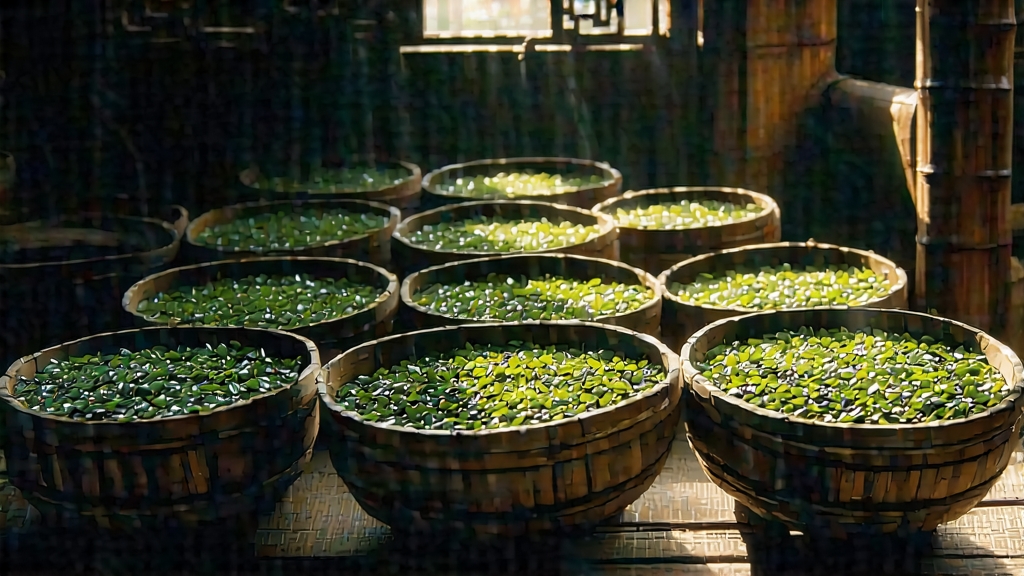
Long before Assam, Ceylon or Earl Grey entered the English lexicon, a small village deep in China’s Wuyi Mountains produced a tea so radically different from the green cakes of the Tang court that foreign merchants coined a new word for it: “black tea.” That village was Tongmu, the year was 1646, and the leaf was Lapsang Souchong—today celebrated as the archetype of all red teas (hong cha) and still the only tea in the world whose flavour is born over a pine fire.
Origin & Legend
Local lore claims the smoke was an accident. Qing soldiers, the story goes, quartered themselves in a Tongmu tea factory during the transition from Ming resistance to Manchu rule. To dry the leaves before dawn’s march, anxious workers rushed the final wilting over open camp-fires of fresh pinewood. The resulting liquor—brisk, copper-red, laced with resinous sweetness—was rejected by local mandarins yet adored by the Dutch traders waiting at Xiamen port. Within a decade, “bohea” (the Fujianese pronunciation of Wuyi) became Europe’s most expensive luxury, outbidding even silk by weight. Archives of the British East India Company show the first recorded shipment of “black bohea” reaching London in 1669, priced at twenty-six shillings per pound, more than a craftsman’s weekly wage.
Micro-Terroir
Tongmu sits inside a national nature reserve whose narrow gorge funnels cool, mineral-rich mists between sheer cliffs of purple sandstone and weathered tuff. Day-night temperature swings of 15 °C slow the growth of the indigenous xiao zhong cultivar, thickening cell walls and concentrating aromatic precursors. The forest itself is a living pantry: Masson pine, Chinese cedar, camphor and wild orchids exhale terpenes that settle on the leaf surface, so that even before firing the maocha carries a faint cool-pine note. Because the reserve bans outside pesticides and limits acreage, authentic Tongmu Lapsang accounts for barely 3 % of the 6,000 tons sold worldwide under the name; the rest are county-wide copies scented with liquid smoke.
Leaf Hierarchy
Chinese wholesalers grade Lapsang not by leaf size alone but by proximity to the village core and by the timing of pluck.
- Zheng Shan Xiao Zhong (“Original Mountain Small Variety”) is picked before Qingming from the highest plots above 800 m; only the unopened bud and first leaf are taken. The finished tea is sleek, pitch-black with golden tips, and the cup balances honeyed longan against a whisper of juniper smoke.
- Wuyi Smoked Souchong uses the standard two-leaf-and-a-bud pluck of mid-April, processed in neighbouring valleys but still pine-smoked; smoke is bolder, liquor darker cocoa.
- Cut-smoked Lapsang, the supermarket version, is made from summer flushes mechanically shredded, quick-oxidised and sprayed with smoked steam—serviceable for Russian caravan blends but lacking the layered calm of the mountain original.
Craft: From Withering to Pine-Fire
The genius of Lapsang lies in timing two fuels at once: heat and resin. Fresh leaves are first wilted on bamboo racks set over dying embers of pine logs whose bark has been stripped to reduce tar. This warm-air wither (28–30 °C, 70 % RH) lasts only two hours, short enough to lock in green chlorophyll yet long enough to soften cells for rolling. Rolling is still done by foot inside a waist-high wooden trough: the craftsman shifts his weight in slow tai-chi circles, rupturing tissue without shredding the leaf. Oxidation proceeds in woven rattan baskets tucked into the warm rafters of the factory; here, catechins convert to theaflavins under the gaze of village grandmothers who judge readiness by nose alone—when the green grassiness gives way to apple-skin fruit, the leaf is ready for its transformative encounter with smoke.
The final firing uses two chambers of a brick kiln. In the lower hearth, pine and cedar logs burn down to glowing coals; upper racks receive the tea in thin layers no deeper than a copper coin. A bamboo curtain traps the smoke, while the master controls draw by adjusting a slate slab at the chimney base. For eight hours the leaf absorbs phenols, gu